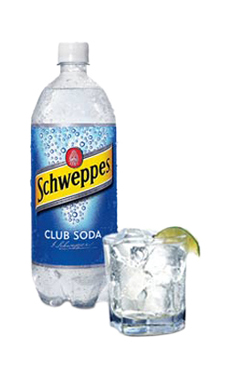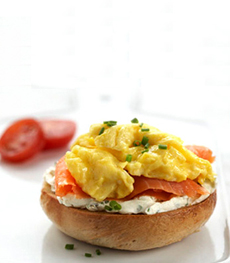Uses For Club Soda & The Difference Between Club Soda & Seltzer
 Drinking club soda is just for starters. Photo courtesy Schweppes. |
You may enjoy it as a refreshing drink or a mixer, or sprinkle it on tablecloth spills. But here are other uses for that bottle of club soda, seltzer or sparkling water (see the differences below). CLUB SODA IN RECIPES 1. Make Fluffier Pancakes. Instead of adding milk or water as the recipe directs, use club soda. The carbonation will help make the pancakes lighter and airier. 2. Make Fluffier Matzoh Balls. As Jewish grandmothers know, seltzer does the same for matzoh balls. 3. Make Fluffier Scrambled Eggs. Our mom used a few splashes of milk to make her scrambled eggs fluffy. Mom’s eggs were great, but carbonated water produces the same results. 4. Make Tempura Batter. The magic of tempura coating is helped by substituting club soda for the water. 5. As A Digestif. Club soda and bitters are a time honored, non-alcoholic digestif, (A digestif is an alcoholic beverage served after a meal to aid digestion). Similarly, sipping on club soda can soothe an upset stomach; feel free to add the bitters, an herbal distillation. |
|
|
There are numerous non-culinary uses for club soda, from cleaning porcelain and stainless steel to preserving newspaper clippings. Check out 10 of them in the original article on Care2.com. CLUB SODA, SELTZER & SPARKLING WATER: WHAT’S THE DIFFERENCE The overall category is carbonated water, also called soda water: water into which carbon dioxide gas under pressure has been dissolved, causing the water to become effervescent. |
||
|
Carbonated Water: In the U.S., carbonated water was known as soda water until after World War II, due to the sodium salts it contained. While today we think of “soda” as a carbonated beverage, the word originally referred to a chemical salt, also called carbonate of soda (sodium carbonate, sodium hydroxide, sodium monoxide). The salts were added as flavoring and acidity regulators, to mimic the taste of natural mineral water. After the war, terms such as sparkling water and seltzer water gained favor. Except for sparkling mineral water, all carbonated water/soda water is made from municipal water supplies (tap water). Carbonated water was invented in Leeds, England in 1767 by British chemist Joseph Priestley, who discovered how to infuse water with carbon dioxide by suspending a bowl of water above a beer vat at a local brewery. Carbonated water changed the way people drank liquor, which had been neat, providing a “mixer” to dilute the alcohol. |
 Club soda makes scrambled eggs fluffier. Photo courtesy American Egg Board. |
|
|
CHECK OUT WHAT’S HAPPENING ON OUR HOME PAGE, THENIBBLE.COM.
|
||


